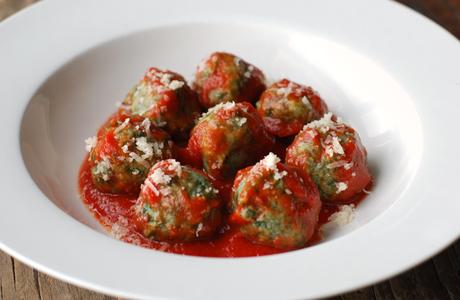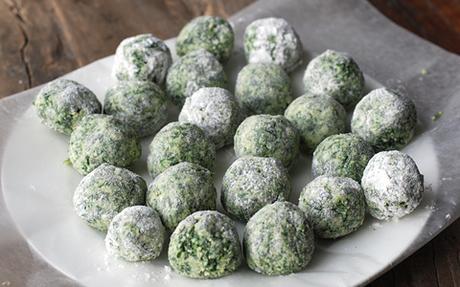
This recipe was adapted from Domenica Marchetti's "Swiss Chard and Spinach Ravioli Nudi", part of her great cookbook The Glorious Vegetables of Italy, entirely dedicated to the prominent role of vegetables in Italian food.
I chose this recipe because I wanted to recreate the gnudi I tasted in a restaurant in Florence during a recent Italian trip, which also happen to have been the first gnudi I ever tasted! Florence is a mere 300 kilometres from my hometown, but regional specialties often remain confined to their native areas.
As pointed out by Domenica, "nudi" (or "gnudi" in Tuscan dialect) means naked. This is because essentially they are "naked" ravioli, i.e. ravioli filling without the pasta wrapper. The use of ricotta makes them light and fluffy, unlike potato gnocchi, which are much denser. It's important to note that gnudi are used in first courses instead of pasta or gnocchi, they're not meant to be served with pasta like some kind of vegetarian meatballs!
Gnudi can be prepared in several different ways. The version chosen by Domenica (and which I recreated) sees the addition of spinach and chard ("bietola" in Italian) for a "green" dough that is delicate and smooth, and which pairs well with plain tomato sauce ( described here). The process of rolling the gnudi into shape is relatively easy, but it requires time and some patience. The result is spectacular - gnudi are a great first course which can set the tone for a very special meal.

Ingredients
Preparation
- Wash the green chard, coarsely rip the leaves and place them, still damp, into a large pot. Cover with a lid and cook for 10 minutes at a medium heat until wilted, stirring occasionally. They will reduce their volume considerably.

- Meanwhile, wash the spinach leaves and cook them in the same way as the chard, but only for 5 minutes.

- Remove the greens from the heat and place them in a colander to cool. When cold enough to handle, squeeze them vigorously with your hands or by wrapping them into a clean tea towel. As Domenica predicted, these quantities yielded about ½ cup of squeezed, cooked greens. Place the greens on a cutting board and chop them finely.

- In a mixing bowl, combine the chopped greens, the ricotta, the yolk, Parmigiano (keeping 1 tablespoon aside), flour, nutmeg, salt, and pepper. Mix thoroughly.

- As you bring a large pot of salted water to a gentle boil, start forming the gnudi. Prepare one bowl filled with flour, next to a plate coated in parchment paper. Using your hands, make balls of dough of about 1 inch (2.5 cm) in diameter. Roll them in the flour until uniformly coated, then place them on the parchment paper.

- Boil the gnudi a batch at a time making sure not to overcrowd them (so that they don't stick to one another, and to ensure the water remains boiling). Gently place them into the simmering water and allow them to cook undisturbed for 6-8 minutes. About half-way through the cooking, they will start floating.
- Gently remove the gnudi from the water using a perforated ladle, and place them into a colander. Keep them warm as you cook the next batch.
- Have the tomato sauce ready and kept warm in a skillet. Place 2-3 tablespoons of tomato sauce in preheated bowls. Roll the gnudi into the skillet with the sauce until coated, then gently place them into the bowls. Sprinkle with grated Parmigiano, serve immediately.
You may also like...
First Courses, New, Recipes dialect, Domenica Marchetti, dough, flour, gnudi, Italian, Italy, pasta, ravioli, recipe, restaurant, ricotta, sauce, spinach, tomato sauce, vegetables, vegetarian Permalink





